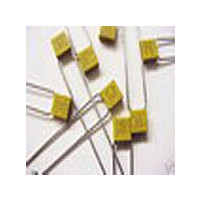M39014/01-1238 Kemet, M39014/01-1238 Datasheet - Page 4

M39014/01-1238
Manufacturer Part Number
M39014/01-1238
Description
Manufacturer
Kemet
Datasheet
1.M3901401-1238.pdf
(15 pages)
Specifications of M39014/01-1238
Tolerance (+ Or -)
20%
Voltage
200VDC
Temp Coeff (dielectric)
X7R
Operating Temp Range
-55C to 125C
Mounting Style
Through Hole
Construction
Radial
Case Style
Molded
Failure Rate
M
Wire Form
Outside Bend
Product Length (mm)
4.83mm
Product Depth (mm)
2.29mm
Product Height (mm)
4.83mm
Product Diameter (mm)
Not Requiredmm
Capacitance
1000pF
Package / Case
Not Required
Lead Free Status / RoHS Status
Not Compliant
tion factor are affected by variations in temperature. The max-
imum capacitance change with temperature is defined by the
temperature characteristic. However, this only defines a “box”
bounded by the upper and lower operating temperatures and
the minimum and maximum capacitance values. Within this
“box”, the variation with temperature depends upon the spe-
cific dielectric formulation. Typical curves for KEMET capaci-
tors are shown in Figures 3, 4, and 5. These figures also
include the typical change in dissipation factor for KEMET
capacitors.
Typically, the insulation resistance at maximum rated temper-
ature is 10% of the 25°C value.
affected by variations in applied AC or DC voltages. For Class
II and III ceramic capacitors, variations in voltage affect only
the capacitance and dissipation factor. The application of DC
voltage higher than 5 vdc reduces both the capacitance and
dissipation factor. The application of AC voltages up to 10-20
Vac tends to increase both capacitance and dissipation factor.
Effect of Temperature: Both capacitance and dissipa-
Insulation resistance decreases with temperature.
Effect of Voltage: Class I ceramic capacitors are not
© KEMET Electronics Corporation, P.O. Box 5928, Greenville, S.C. 29606, (864) 963-6300
APPLICATION NOTES FOR MULTILAYER
CERAMIC CAPACITORS
At higher AC voltages, both capacitance and dissipation factor
begin to decrease.
voltage are shown in Figure 6 for KEMET X7R capacitors and
Figure 7 for KEMET Z5U capacitors.
tance and dissipation factor. Typical curves for KEMET multi-
layer ceramic capacitors are shown in Figures 8 and 9.
tant consideration in the application of multilayer ceramic
capacitors. Total impedance of the capacitor is the vector of the
capacitive reactance, the inductive reactance, and the ESR, as
illustrated in Figure 2. As frequency increases, the capacitive
reactance decreases. However, the series inductance (L)
shown in Figure 1 produces inductive reactance, which
increases with frequency. At some frequency, the impedance
ceases to be capacitive and becomes inductive. This point, at
the bottom of the V-shaped impedance versus frequency
curves, is the self-resonant frequency. At the self-resonant fre-
quency, the reactance is zero, and the impedance consists of
the ESR only.
multilayer ceramic capacitors are shown in Figures 10, 11, and
12. These curves apply to KEMET capacitors in chip form, with-
out leads. Lead configuration and lead length have a significant
impact on the series inductance. The lead inductance is
approximately 10nH/inch, which is large compared to the
inductance of the chip. The effect of this additional inductance
is a decrease in the self-resonant frequency, and an increase
in impedance in the inductive region above the self-resonant
frequency.
dielectrics change with time as well as with temperature, volt-
age and frequency. This change with time is known as “aging.”
It is caused by gradual realignment of the crystalline structure
of the ceramic dielectric material as it is cooled below its Curie
temperature, which produces a loss of capacitance with time.
The aging process is predictable and follows a logarithmic
decay. Typical aging rates for C0G, X7R, and Z5U dielectrics
are as follows:
shown in Figure 13.
ed to a temperature above its Curie point for some period of
time, de-aging will occur and the capacitor will regain the
capacitance lost during the aging process. The amount of de-
aging depends on both the elevated temperature and the
length of time at that temperature. Exposure to 150°C for one-
half hour or 125°C for two hours is usually sufficient to return
the capacitor to its initial value.
after de-aging, capacitance measurements are usually delayed
for at least 10 hours after the de-aging process, which is often
referred to as the “last heat.” In addition, manufacturers utilize
the aging rates to set factory test limits which will bring the
capacitance within the specified tolerance at some future time,
to allow for customer receipt and use. Typically, the test limits
are adjusted so that the capacitance will be within the specified
tolerance after either 1,000 hours or 100 days, depending on
the manufacturer and the product type.
Typical curves showing the effect of applied AC and DC
Effect of Frequency: Frequency affects both capaci-
The variation of impedance with frequency is an impor-
Typical impedance versus frequency curves for KEMET
Effect of Time: The capacitance of Class II and III
Typical aging curves for X7R and Z5U dielectrics are
The aging process is reversible. If the capacitor is heat-
Because the capacitance changes rapidly immediately
C0G
X7R
Z5U
None
2.0% per decade of time
5.0% per decade of time
7















